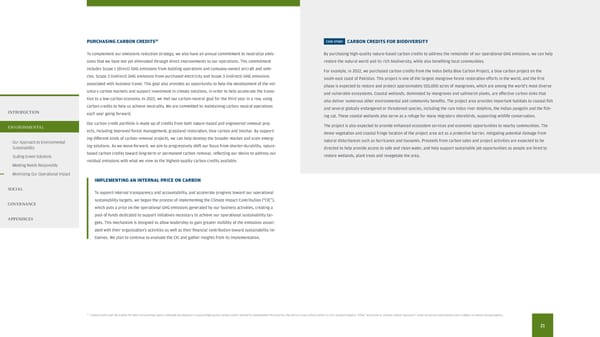10 CASE STUDY PURCHASING CARBON CREDITS CARBON CREDITS FOR BIODIVERSITY To complement our emissions reduction strategy, we also have an annual commitment to neutralize emis- By purchasing high-quality nature-based carbon credits to address the remainder of our operational GHG emissions, we can help sions that we have not yet eliminated through direct improvements to our operations. This commitment restore the natural world and its rich biodiversity, while also benefting local communities. includes Scope 1 (direct) GHG emissions from building operations and company-owned aircraft and vehi- For example, in 2022, we purchased carbon credits from the Indus Delta Blue Carbon Project, a blue carbon project on the cles, Scope 2 (indirect) GHG emissions from purchased electricity and Scope 3 (indirect) GHG emissions south-east coast of Pakistan. This project is one of the largest mangrove forest restoration eforts in the world, and the frst associated with business travel. This goal also provides an opportunity to help the development of the vol- phase is expected to restore and protect approximately 555,000 acres of mangroves, which are among the world’s most diverse untary carbon markets and support investment in climate solutions, in order to help accelerate the transi- and vulnerable ecosystems. Coastal wetlands, dominated by mangroves and saltmarsh plants, are efective carbon sinks that tion to a low-carbon economy. In 2022, we met our carbon-neutral goal for the third year in a row, using also deliver numerous other environmental and community benefts. The project area provides important habitats to coastal fsh carbon credits to help us achieve neutrality. We are committed to maintaining carbon neutral operations and several globally endangered or threatened species, including the rare Indus river dolphins, the Indian pangolin and the fsh- INTRODUCTION each year going forward. ing cat. These coastal wetlands also serve as a refuge for many migratory shorebirds, supporting wildlife conservation. Our carbon credit portfolio is made up of credits from both nature-based and engineered removal proj- The project is also expected to provide enhanced ecosystem services and economic opportunities to nearby communities. The ENVIRONMENTAL ects, including improved forest management, grassland restoration, blue carbon and biochar. By support- dense vegetation and coastal fringe location of the project area act as a protective barrier, mitigating potential damage from ing diferent kinds of carbon removal projects, we can help develop the broader market and scale emerg- natural disturbances such as hurricanes and tsunamis. Proceeds from carbon sales and project activities are expected to be Our Approach to Environmental ing solutions. As we move forward, we aim to progressively shift our focus from shorter-durability, nature- Sustainability directed to help provide access to safe and clean water, and help support sustainable job opportunities as people are hired to Scaling Green Solutions based carbon credits toward long-term or permanent carbon removal, refecting our desire to address our restore wetlands, plant trees and revegetate the area. residual emissions with what we view as the highest-quality carbon credits available. Meeting Needs Responsibly Minimizing Our Operational Impact IMPLEMENTING AN INTERNAL PRICE ON CARBON SOCIAL To support internal transparency and accountability, and accelerate progress toward our operational sustainability targets, we began the process of implementing the Climate Impact Contribution (“CIC”), GOVERNANCE which puts a price on the operational GHG emissions generated by our business activities, creating a pool of funds dedicated to support initiatives necessary to achieve our operational sustainability tar- APPENDICES gets. This mechanism is designed to allow leadership to gain greater visibility of the emissions associ- ated with their organization’s activities as well as their fnancial contribution toward sustainability ini- tiatives. We plan to continue to evaluate the CIC and gather insights from its implementation. 10 Carbon credits and the market for them are evolving rapidly. Although we endeavor to source high-quality carbon credits verifed by independent third parties, the ability to use carbon credits to fully and permanently "ofset" emissions or achieve carbon "neutrality" relies on certain assumptions and is subject to debate among experts. 21
 2022 Environmental Social Governance Report Page 22 Page 24
2022 Environmental Social Governance Report Page 22 Page 24